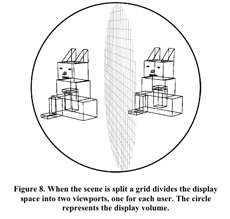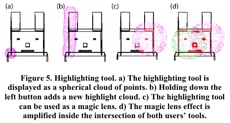Back in Florence, at CHI2008, I attended an interesting presentation of Tovi Grossman (DGP, University of Toronto), on volumetric displays. A volumetric display is a graphical device that forms a visual representation of an object in three physical dimensions, as opposed to the planar image of traditional screens that simulate depth through a number of different visual effects. The model he presented, in fact, used a fast-turning mirrors over which an image was projected thus giving a full sense of depth.
Tovi’s PhD thesis inquired how to interact with volumetric displays. Tovi and colleagues designed techniques for selection and interaction with 3D models represented through these displays. Their approach consisted in tracking the hands of the users and the users body using infrared markers and simple video analysis techniques. Volumetric displays are limited because they do not allow deictic gestures on the surface of the model.
The paper that he presented at CHI08 suggest different techniques that can help to overcome this limitation. For instance he suggest the possibility of using a spherical highlighter: a semi-transparent sphere that can be used to highlight a certain part of the model. Different colors can be used by different users. The access control to the view and feature of the drawing raises also interesting questions on how to grant equal participation to two or more users. Their idea, to this end, was that of splitting the drawing in two each sub-model could then be controlled by a single user. Of course, the natural extension of this system is the support of remote collaboration. However, Tovi’s thesis work did not cover this topic. We can think of many other issues that would raise when collaborators are not co-located. Interesting research questions might include how to best recreate the remote collaborator’s point of view on the model (a 3D minimap à la Greenberg & Gutwin?), and how to best offer explicit referencing support over a 3D surface.


